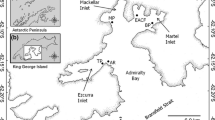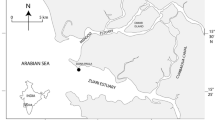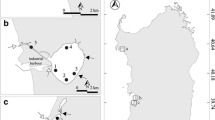Abstract
Due to its ecological context, the Toulon bay represents a site of scientific interest to study temporal plankton distribution, particularly pico- and nanophytoplankton dynamics. A monthly monitoring was performed during a two-year cycle (October 2013–December 2015) at two coupled sampling sites, referred to as Little and Large bays, which had different morphometric characteristics and human pressures. Flow cytometry analyses highlighted the fact that pico- and nanophytoplankton were more abundant in the eutrophic Little bay. Furthermore, it evidenced two community structures across the Toulon bays: at times, a co-dominance of picoeukaryotes, nanoeukaryotes, Synechococcus 1-like cells and Prochlorococcus-like cells was found, and at other times, a Synechococcus 1-like dominated community existed. The alternation of one structure or the other can be explained by a combined action of temperature regime, nutrient conditions and degree of contamination. This study showed that pico- and nanophytoplankton dynamics were mainly driven by temperature in both sites, as in other temperate Mediterranean regions. Thus, the community was mainly composed of picoeukaryotes and Prochlorococcus-like cells in the winter (< 15 °C), while it was dominated by Synechococcus 1-like cells in the summer (> 20 °C). Additionally, the multiple human stressors in the Little bay seemed to affect the increase in abundance of Synechococcus 1-like cells as they were preferentially observed in the Large bay.









Similar content being viewed by others
References
Agawin, Nona S.R., Carlos M. Duarte, and Susana Agustí. 1998. Growth and abundance of Synechococcus sp. in a Mediterranean Bay: Seasonality and relationship with temperature. Marine Ecology Progress Series 170: 45–53.
Agawin, Nona S.R., Carlos M. Duarte, and Susana Agustí. 2000. Nutrient and temperature control of the contribution of picoplankton to phytoplankton biomass and production. Limnology and Oceanography 45 (3): 591–600.
Amorim, Ana L., Pablo León, Jesús M. Mercado, Dolores Cortés, Francisco Gómez, Sebastien Putzeys, Soluna Salles, and Lidia Yebra. 2016. Controls of picophytoplankton abundance and composition in a highly dynamic marine system, the Northern Alboran Sea (Western Mediterranean). Journal of Sea Research 112: 13–22.
Anderson, Marti J. 2001. A new method for non-parametric multivariate analysis of variance. Austral Ecology 26: 32–46.
Babić, Ivana, Ines Petrić, Sunčica Bosak, Hrvoje Mihanović, Iris Dupčić Radić, and Zrinka Ljubešić. 2017. Distribution and diversity of marine picocyanobacteria community: Targeting of Prochlorococcus ecotypes in winter conditions (southern Adriatic Sea). Marine Genomics 36: 3–11.
Bec, Béatrice, Yves Collos, Philippe Souchu, André Vaquer, Jacques Lautier, Annie Fiandrino, Laurent Benau, Valérie Orsoni, and Thierry Laugier. 2011. Distribution of picophytoplankton and nanophytoplankton along an anthropogenic eutrophication gradient in French Mediterranean coastal lagoons. Aquatic Microbial Ecology 63 (1): 29–45.
Belin, Catherine, and Bernard Raffin. 1998. Toxic and harmful phytoplankton species on the French coast from 1984 to 1995, results of the French phytoplankton and phycotoxins monitoring network (REPHY). Rapport IFREMER. http://envlit.ifremer.fr/content/download/27379/222288/file/Rephy_84_95.pdf. Accessed August 2017.
Bell, Thomas, and Jacob Kalff. 2001. The contribution of picophytoplankton in marine and freshwater systems of different trophic status and depth. Limnology and Oceanography 46 (5): 1243–1248.
Bogé, Gérard, Magali Lespilette, Dominique Jamet, and Jean-Louis Jamet. 2017. Role of DOP on the alkaline phosphatase activity of size fractionated plankton in coastal waters in the NW Mediterranean Sea (Toulon Bay, France). Marine Pollution Bulletin 117 (1-2): 264–273.
Bosak, Sunčica, Tina Šilović, Zrinka Ljubešić, Grozdan Kušpilić, Branka Pestorić, Sladana Krivolapić, and Damir Viličić. 2012. Phytoplankton size structure and species composition as an indicator of trophic status in transitional ecosystems: The case study of a Mediterranean fjord-like karstic bay. Oceanologica 54 (2): 255–286.
Caroppo, Carmela, Loredana Stabili, Michele Aresta, Cinzia Corinaldesi, and Roberto Danovaro. 2006. Impact of heavy metals and PCBs on marine picoplankton. Environmental Toxicology 21 (6): 541–551.
Clementson, Lesley A., and Sally E. Wayte. 1992. The effect of frozen storage of open-ocean seawater samples on the concentration of dissolved phosphate and nitrate. Water Research 26 (9): 1171–1176.
Coclet, Clément, Cédric Garnier, Floriane Delpy, Dominique Jamet, Gaël Durrieu, Christophe Le Poupon, Marie Mayer, and Benjamin Misson. 2017. Trace metal contamination as a toxic and structuring factor impacting ultraphytoplankton communities in a multicontaminated Mediterranean coastal area. Progress in Oceanography. https://doi.org/10.1016/j.pocean.2017.06.006.
Dang, Duc Huy, Véronique Lenoble, Gaël Durrieu, Jean-Ulrich Mullot, Stéphane Mounier, and Cédric Garnier. 2014. Sedimentary dynamics of coastal organic matter: An assessment of the porewater size/reactivity model by spectroscopic techniques. Estuarine, Coastal and Shelf Science 151: 100–111.
Debelius, Bibiana, Jesús M. Forja, Ángel DelValls, and Luis M. Lubián. 2009. Toxicity of copper in natural marine picoplankton populations. Ecotoxicology 18 (8): 1095–1103.
Debelius, Bibiana, Jesús M. Forja, and Luis M. Lubián. 2011. Toxicity of copper, nickel and zinc to Synechococcus populations from the Strait of Gibraltar. Journal of Marine Systems 88 (1): 113–119.
Denis, Michel, Valérie Martin, and Valérie Andersen. 2000. Short-term variations of the vertical distribution of cyanobacteria in the open Mediterranean Sea. Scientia Marina 64 (2): 157–163.
Dore, John E., Terrence Houlihan, Dale V. Hebel, Georgia Tien, Luis Tupas, and David M. Karl. 1996. Freezing as a method of sample preservation for the analysis of dissolved inorganic nutrients in seawater. Marine Chemistry 53 (3-4): 173–185.
Dubelaar, George B.J., and Richard R. Jonker. 2000. Flow cytometry as a tool for the study of phytoplankton. Scientia Marina 64 (2): 135–156.
Duffa, Céline, François Dufois, and Sylvain Coudray. 2011. An operational model to simulate post-accidental radionuclide transfers in Toulon marine area: Preliminary development. Ocean Dynamics 61 (11): 1811–1821.
Dufresne, Christiane, Céline Duffa, and Vincent Rey. 2014. Wind-forced circulation model and water exchanges through the channel in the Bay of Toulon. Ocean Dynamics 64 (2): 209–224.
Dugenne, Mathilde, Melilotus Thyssen, David Nerini, Claude Mante, Jean-Christophe Poggiale, Nicole Garcia, Fabrice Garcia, and Gérald J. Grégori. 2014. Consequence of a sudden wind event on the dynamics of a coastal phytoplankton community: An insight into specific population growth rates using a single cell high frequency approach. Frontiers in Microbiology 5: 485. https://doi.org/10.3389/fmicb.2014.00485.
DuRand, Michele, Robert J. Olson, and Sallie W. Chisholm. 2001. Phytoplankton population dynamics at the Bermuda Atlantic—Time-series station in the Sargasso Sea. Deep-Sea Research II 48 (8-9): 1983–2003.
Echeveste, Pedro, Susana Agustí, and Antonio Tovar-Sánchez. 2012. Toxic thresholds of cadmium and lead to oceanic phytoplankton: Cell size and ocean bassin-dependant effect. Environmental Toxicology and Chemistry 31 (8): 1887–1894.
Flombaum, Pedro, José L. Gallegos, Rodolfo A. Gordillo, José Rincón, Lina L. Zabala, Nianzhi Jiao, David M. Karl, William K.W. Li, Michael W. Lomas, Daniele Veneziano, Carolina S. Vera, Jasper A. Vrugt, and Adam C. Martiny. 2013. Present and future global distributions of the marine cyanobacteria Prochlorococcus and Synechococcus. PNAS 110 (24): 9824–9829.
Fogg, Gordon E. 1995. Some comments on picoplankton and its importance in the pelagic ecosystem. Aquatic Microbial Ecology 9: 33–39.
Goffart, Anne, Jean-Henri Hecq, and Louis Legendre. 2015. Drivers of the winter-spring phytoplankton bloom in a pristine NW Mediterranean site, the bay of Calvi (Corsica): A long-term study (1979–2011). Progress in Oceanography 137 (A): 121–139.
Grégori, Gérald, Alfredo Colosimo, and Michel Denis. 2001. Phytoplankton group dynamics in the Bay of Marseilles during a 2-year survey based on analytical flow cytometry. Cytometry 44 (3): 247–256.
Jamet, Jean-Louis, Gérard Bogé, Simone Richard, Claude Geneys, and Dominique Jamet. 2001. The zooplankton community in bays of Toulon area (northwest Mediterranean Sea, France). Hydrobiologia 457 (1/3): 155–165.
Joanny, Michel, Catherine Belin, Didier Claisse, Laurence Miossec, Jean-Paul Berthome, Anne Grouhel, and Bernard Raffin. 1993. Qualité du milieu marin littoral. Rapport IFREMER. http://archimer.ifremer.fr/doc/00334/44475/44153.pdf. Accessed August 2017.
Jouan, Matthieu, Pierre Garreau, and Olivier Raillard. 2001. Modélisation de la Rade de Toulon: test méthodologique. Rapport IFREMER.
Jyothibabu, Retnamma, Arya P. Mohan, Jagadeesan Loganthan, A. Anjusha, K.R. Muraleedharan, Raj Lallu, Krishna Kiran, and Nanappan Ullas. 2013. Ecology and trophic preference of picoplankton and nanoplankton in the Gulf of Mannar and the Palk Bay, southeast coast of India. Journal of Marine Systems 111–112: 29–44.
Karydis, Michael, and Dimitra Kitsiou. 2012. Eutrophication and environmental policy in the Mediterranean Sea: A review. Environmental Monitoring and Assessment 184 (8): 4931–4984.
Kirkham, Amy R., Ludwig E. Jardillier, Ana Tiganescu, John Pearman, Mikhail V. Zubkov, and David J. Scanlan. 2011. Basin-scale distribution patterns of photosynthetic picoeukaryotes along an Atlantic Meridional Transect. Environmental Microbiology 13 (4): 975–990.
Lomas, Michael W., and S. Bradley Moran. 2011. Evidence for aggregation and export of cyanobacteria and nano-eukaryotes from the Sargasso Sea euphotic zone. Biogeosciences 8 (1): 203–216.
Mann, Henry B., and Donald R. Whitney. 1947. On a test of whether one of two random variables is stochastically larger than the other. The Annals of Mathematical Statistics 18 (1): 50–60.
Marie, Dominique, Frédéric Partensky, Stephan Jacquet, and Daniel Vaulot. 1997. Enumeration and cell cycle analysis of natural populations of marine picoplankton by flow cytometry using the nucleic acid stain SYBR Green I. Applied and Environmental Microbiology 63 (1): 186–193.
Marie, Dominique, Frédéric Partensky, Daniel Vaulot, and Corina Brussaard. 2001. Enumeration of phytoplankton, bacteria, and viruses in marine samples. In Current protocols in cytometry, eds. J. Paul Robinson, Zbyszek Darzynkiewicz, Philipp N. Dean, Alberto Orfao, Peter S. Rabinovitch, Carleton C. Stewart, Hans J. Tanke, and Leon L. Wheeless, Supplement 10: 11.11.1–11.11.15. New York: Wiley.
Marie, Dominique, Fabienne Rigaut-Jalabert, and Daniel Vaulot. 2014. An improved protocol for flow cytometry analysis of phytoplankton cultures and natural samples. Cytometry. Part A 85 (11): 962–968.
Mella-Flores, Daniella, Sophie Mazard, Florian Humily, Frédéric Partensky, Frédéric Mahé, Laetitia Bariat, Claude Courties, Dominique Marie, Joséphine Ras, Romain Mauriac, Christian Jeanthon, El Mahdi Bendif, Martin Ostrowski, David J. Scanlan, and Laurence Garczarek. 2011. Is the distribution of Prochlorococcus and Synechococcus ecotypes in the Mediterranean Sea affected by global warming? Biogeosciences 8 (9): 2785–2804.
Mella-Flores, Daniella, Christophe Six, Morgane Ratin, Frédéric Partensky, Christophe Boutte, Gildas Le Corguillé, Dominique Marie, Nicolas Blot, Priscillia Gourvil, Christian Kolowrat, and Laurence Garczarek. 2012. Prochlorococcus and Synechococcus have evolved different adaptive mechanisms to cope with light and UV stress. Frontiers in Microbiology 3: 285. https://doi.org/10.3389/fmicb.2012.00285.
Moisan, Tiffany A., Kristen L. Blattner, and Carla P. Makinen. 2010. Influences of temperature and nutrients on Synechococcus abundance and biomass in the southern Mid-Atlantic Bight. Continental Shelf Research 30 (12): 1275–1282.
Murphy, James, and John P. Riley. 1962. A modified single solution method for the determination of phosphate in natural waters. Analytica Chimica Acta 27: 31–36.
Murphy, Cole D., Mitchell S. Roodvoets, Emily J. Austen, Allison Dolan, Audrey Barnett, and Douglas A. Campbell. 2017. Photoinactivation of photosystem II in Prochlorococcus and Synechococcus. PLoS One 12 (1): e0168991. https://doi.org/10.1371/journal.pone.0168991.
Nicolau, Rudy, Adriana Galera-Cunha, and Yves Lucas. 2006. Transfer of nutrients and labile metals from the continent to the sea by a small Mediterranean river. Chemosphere 63 (3): 469–476.
Olson, Robert J., Erik R. Zettler, and Michele D. DuRand. 1993. Phytoplankton analysis using flow cytometry. In Handbook of methods in aquatic microbial ecology, ed. Paul F. Kemp, Barry F. Sherr, Evelyn B. Sherr, and Jonathan J. Cole, 175–186. Boca Raton: Lewis Publishers.
Palenik, Brian, Qinghu Ren, Chris L. Dupont, Garry S. Myers, John F. Heidelberg, Jonathan H. Badger, Ramana Madupu, William C. Nelson, Lauren M. Brinkac, Robert J. Dodson, A. Scott Durkin, Sean C. Daugherty, Stephen A. Sullivan, Hoda Khouri, Yasmin Mohamoud, Rebecca Halpin, and Ian T. Paulsen. 2006. Genome sequence of Synechococcus CC9311: Insights into adaptation to a coastal environment. PNAS 10 (36): 13555–13559.
Pan, Luoan, Jing Zhang, and Lihua Zhang. 2007. Picophytoplankton, nanophytoplankton, heterotrophic bacteria and viruses in the Changjiang Estuary and adjacent coastal waters. Journal of Plankton Research 29 (2): 187–197.
Partensky, Frédéric, Jean Blanchot, and Daniel Vaulot. 1999. Differential distribution and ecology of Prochlorococcus and Synechococcus in ocean waters. A review. Bulletin de l’Institut océanographique (Monaco) 19: 457–475.
Pougnet, Frédérique, Jörg Schäfer, Lionel Dutruch, Cédric Garnier, Erwan Tessier, Duc Huy Dang, Laurent Lanceleur, Jean-Ulrich Mullot, Véronique Lenoble, and Gérard Blanc. 2014. Sources and historical record of tin and butyl-tin species in a Mediterranean bay (Toulon Bay, France). Environmental Science and Pollution Research 21 (10): 6640–6651.
Ribeiro, Catherine Gérikas, Dominique Marie, Adriana Lopes dos Santos, Frederico Pereira Brandini, and Daniel Vaulot. 2016. Estimating microbial populations by flow cytometry: Comparison between instruments. Limnology and Oceanography 14 (11): 750–758.
Rossi, Nadège. 2008. Écologie des communautés planctoniques méditerranéennes et étude des métaux lourds (Cuivre, Plomb, Cadmium) dans différents compartiments de deux écosystèmes côtiers (Toulon, France). PhD Thesis, Université du Sud-Toulon Var.
Rossi, Nadège, and Jean-Louis Jamet. 2008. In situ heavy metals (copper, lead and cadmium) in different plankton compartments and suspended particulate matter in two coupled Mediterranean coastal ecosystems (Toulon Bay, France). Marine Pollution Bulletin 56 (11): 1862–1870.
Rossi, Nadège, and Jean-Louis Jamet. 2009. Structure and succession of plankton communities in two Mediterranean neighbouring coastal ecosystems (Toulon Bays, France). In New oceanography research developments, ed. Louis Martorino and Karl Puopolo, 269–282. New York: Nova Science Publishers.
Salhi, Nousseiba, Habiba Zmerli Triki, Juan Carlos Molinero, Laabir Mohamed, E. Sehli, Amel Bellaaj-Zouari, Néjib Daly Yahia, and Ons Kefi-Daly. 2017. Seasonal variability of picoplankton under contrasting environments in northern Tunisian coasts, southwestern Mediterranean Sea. Marine Pollution Bulletin. 129 (2): 866–874. https://doi.org/10.1016/j.marpolbul.2017.10.029.
Šantić, Danijela, Nada Krstulović, Mladen Šolić, and Grozdan Kušpilić. 2011. Distribution of Synechococcus and Prochlorococcus in the central Adriatic Sea. Acta Adriatica 52 (1): 101–114.
Serranito, Bruno, Anaïs Aubert, Lars Stemmann, Nadège Rossi, and Jean-Louis Jamet. 2016. Proposition of indicators of anthropogenic pressure in the Bay of Toulon (Mediterranean Sea) based on zooplankton time-series. Continental Shelf Research 121: 3–12.
Siokou-Frangou, Ioanna, Urania Christaki, Maria Grazia Mazzocchi, Marina Montresor, Maurizio Ribera d'Alcalá, Dolors Vaqué, and Adriana Zingone. 2010. Plankton in the open Mediterranean Sea: A review. Biogeosciences 7 (5): 1543–1586.
Somogyi, Boglárka, Tamás Felföldi, József Vanyovski, Ákos Ágyi, Károly Márialigeti, and Lajos Vörös. 2009. Winter bloom of picoeukaryotes in Hungary shallow turbid soda pans and the role of light and temperature. Aquatic Ecology 43 (3): 735–744.
Stockner, John G. 1988. Phototrophic picoplankton: An overview from marine and freshwater ecosystems. Limnology and Oceanography 33 (4, part 2): 765–775.
Strickland, John D.H. 1965. Phytoplankton and marine primary production. Annual Review of Microbiology 19 (1): 127–162.
Strickland, John D.H., and Tim R. Parsons. 1968. A practical handbook of seawater analysis—Determination of reactive phosphorus. Journal of the Fisheries Research Board of Canada 167: 49–56.
Talarmin, Agathe, France Van Wambeke, Philippe Lebaron, and Thierry Moutin. 2015. Vertical partitioning of phosphate uptake among picoplankton groups in the low Pi Mediterranean Sea. Biogeosciences 12 (4): 1237–1247.
Tessier, Erwan. 2012. Diagnostic de la contamination sédimentaire par les métaux/métalloïdes dans la rade de Toulon et mécanismes contrôlant leur mobilité. PhD Thesis, Université de Toulon et du Var.
Tessier, Erwan, Cédric Garnier, Jean-Ulrich Mullot, Véronique Lenoble, Mireille Arnaud, Michel Raynaud, and Stéphane Mounier. 2011. Study of the spatial and historical distribution of sediment inorganic contamination in the Toulon Bay (France). Marine Pollution Bulletin 62 (10): 2075–2086.
Thyssen, Melilotus, Gérald J. Grégori, Jean-Michel Grisoni, Maria Luiza Pedrotti, Laure Mousseau, Luis F. Artigas, Sophie Marro, Nicole Garcia, Ornella Passafiume, and Michel J. Denis. 2014. Onset of the spring bloom in the northwestern Mediterranean Sea: Influence of environmental pulse events on the in situ hourly-scale dynamics of the phytoplankton community structure. Frontiers in Microbiology 5 (387): 1–16.
Tréguer, Paul, and Pierre Le Corre. 1975. Manuel d'analyse des sels nutritifs dans l'eau de mer (utilisation de l'AutoAnalyzer II Technicon®), 2ème édition. Brest: Université Bretagne Occidentale.
Uitz, Julia, Dariusz Stramski, Bernard Gentili, Fabrizio D’Ortenzio, and Hervé Claustre. 2012. Estimates of phytoplankton class-specific and total primary production in the Mediterranean Sea from satellite ocean color observations. Global Ecological Cycles 26 (2): GB2024. https://doi.org/10.1029/2011GB004055.
Vaulot, Daniel, and Frédéric Partensky. 1990. Winter presence of prochlorophytes in surface waters of the Northwestern Mediterranean Sea. Limnology and Oceanography 35 (5): 1156–1164.
Veldhuis, Marcel J.W., and Gijsbert W. Kraay. 2000. Application of flow cytometry in marine phytoplankton research: Current application and future perspectives. Scientia Marina 64 (2): 121–134.
Yentsch, Clarice M., and Paul K. Horan. 1989. Cytometry in the aquatic sciences. Cytometry 10 (5): 497–499.
Yentsch, Clarice M., Paul K. Horan, Katharine Muirhead, Quay Dortch, Elin Haugen, Louis Legendre, Lynda S. Murphy, Mary Jane Perry, David A. Phinney, Shirley A. Pomponi, Richard W. Spinrad, Michelle Wood, Charles S. Yentsch, and Bernard J. Zahuranec. 1983. Flow cytometry and cell sorting: A technique for analysis and sorting of aquatic particles. Limnology and Oceanography 28 (6): 1275–1280.
Acknowledgements
This research was financed by in-house funding from the EBMA (Marine Ecology and Biology) research team (PROTEE laboratory EA 3819, University of Toulon, France). We are grateful to the Regional Flow Cytometry Platform for Microbiology (PRECYM) of the Mediterranean Institute of Oceanography (MIO UM 110, Aix-Marseille University, France) for their support concerning the arrangement of our flow cytometry protocols and sample preparation. The authors thank Jingwei YANG (PhD) for help in implementing flow cytometry in the laboratory, as well as the two anonymous reviewers that provided helpful comments on the earlier draft of this manuscript.
Funding
This research was financed by in-house funding from the EBMA (Marine Ecology and Biology) research team (PROTEE laboratory EA 3819, University of Toulon, France).
Author information
Authors and Affiliations
Corresponding authors
Ethics declarations
Conflict of Interest
Floriane Delpy declares that she has no conflict of interest. Bruno Serranito declares that he has no conflict of interest. Jean-Louis Jamet declares that he has no conflict of interest. Gérald Gregori declares that he has no conflict of interest. Christophe Le Poupon declares that he has no conflict of interest. Dominique Jamet declares that she has no conflict of interest.
Ethical Approval
This article does not contain any studies with animals performed by any of the authors.
Additional information
Communicated by Hans W. Paerl
Rights and permissions
About this article
Cite this article
Delpy, F., Serranito, B., Jamet, JL. et al. Pico- and Nanophytoplankton Dynamics in Two Coupled but Contrasting Coastal Bays in the NW Mediterranean Sea (France). Estuaries and Coasts 41, 2039–2055 (2018). https://doi.org/10.1007/s12237-018-0412-9
Received:
Revised:
Accepted:
Published:
Issue Date:
DOI: https://doi.org/10.1007/s12237-018-0412-9




